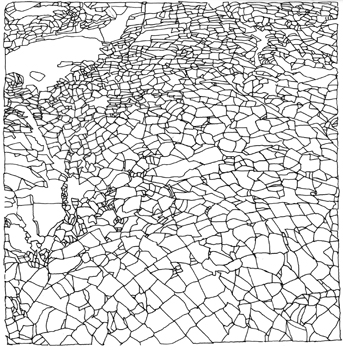Found a booklet relating de Hooch's work to that of Vermeer: Meeting of Masterpieces series,…
Bien étonnés de se trouver ensemble
 Wanted to talk about the work of Irene Kopelman – she gave a presentation of her work last week when we were doing a workshop week at Expodium.
Wanted to talk about the work of Irene Kopelman – she gave a presentation of her work last week when we were doing a workshop week at Expodium.
Irene talked about the importance that drawing has for her and the effect it has on her. A section of Mika Hannula’s book ‘Politics, Identity and Public Space’ is devoted to her work. Quote, page 147: “It was only by trying first to photograpically record the patterns and after experiencing drawing them that I understood the complete different mindframe that each of those procedures entails and the whole set of different associations that the mind undergoes with the different procedures”.
As I remember from her talk, she visited the Etymological Collection of the University of Amsterdam many times, studying the way some 8 million insects are processed and stored. She had the experience of first photographing the wings of butterflies within the same classification or genus, and then drawing them. Drawing the wings made her see the minute differences that exist between butterflies of the same genus, a fact that photographing them had not brought home to her.
This is a thing I am really interested in. I even have a theory of sorts ( to be checked, of course): I think the mind stores just enough information about a subject (here: butterfly wings) to make a mental map of it, so as to be able to recognise the genus and its particular colours and patterns the next time. So only a ‘general idea’ of this particular genus is retained, enough for recognition but not for distinction. Now when we draw, the mind is forced to take in the minute details and differences, and the object is stored as an individual object and not a mental map. Maybe in some other part of the brain, even, not a part that is concerned with recognition but a part that deals with specifics and differences.
I go through the same when I have met someone and later get to know him or her better. People I have met but have not really made contact with I will recognise a next time. But when I get to know them better, their faces change – I cannot describe what happens better than that. It is as if they get more detail, more color, more character. I think this might be the same process at work as with Irene’s butterfly wings.
Talking with Henk Slager today about artistic research and scientific research, their common ground and their differences, I realised that Irene’s project is a great example underpinning our discussion. The scientific method of classification, organisation and structure is visible in the Entomological Collection Irene visited. Then the artistic method of painstakingly recording the minutest of differences between the butterflies of one genus, giving them back their individuality and asking questions about the process of classification that has such practical advantages. But no real meaning in nature, or for the butterflies themselves: “Bien étonnés de se trouver ensemble”
Found an interesting article on the Net by Janet Grishy . Quote: “Encoding is the term for how the brain stores away memories. The first step may happen in the hippocampus, which, together with the frontal cortex, analyzes information from the senses and decides whether a memory is worth recording. The hippocampus is thought to be involved in declarative memory and spatial memory. Declarative memories are the memories that can be put in words, such as the events of a summer vacation, or knowledge about calculus, if any. Spatial memory is thought to be that form of memory that describes one’s location in space. On the other hand, the amygdala plays a role in encoding memories of emotionally stressful events.”
“However, it is still possible for a person without a functioning hippocampus to learn a new skill, such as jumping rope, because procedural memories are encoded through a different route.”
“The amygdala also processes information from the senses, especially the sense of smell. It encodes those emotional memories that often modify the organism’s behavior.”

| « Manifesto-revised | <-- previous post | next post --> | Popper, Newton’s apple and dwarves on the shoulders of giants. » |
|---|







